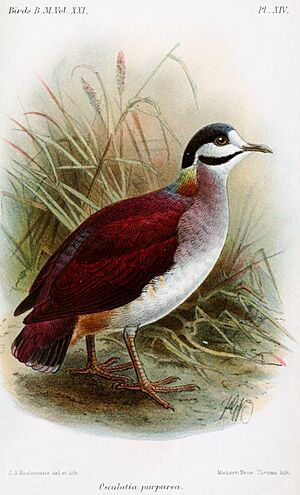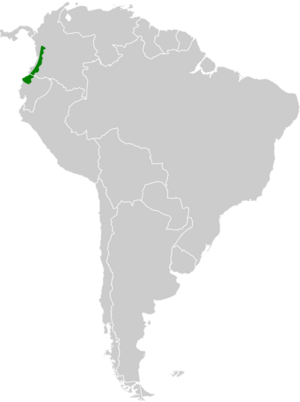Purple quail-dove facts for kids
Quick facts for kids Purple quail-dove |
|
|---|---|
 |
|
| Conservation status | |
| Scientific classification | |
| Genus: |
Geotrygon
|
| Species: |
purpurata
|
 |
|
| Synonyms | |
|
Osculatia saphirina purpurata |
|
The purple quail-dove (Geotrygon purpurata) is a beautiful species of bird. It belongs to the Columbidae family, which includes all doves and pigeons. This special bird lives in the forests of Colombia and Ecuador. It is known for its amazing colors and its quiet life on the forest floor.
Contents
About This Bird's Family
For a while, people thought the purple quail-dove was just a type of sapphire quail-dove. Back then, it was called Osculatia saphirina. But scientists later studied it more closely. In the early 2010s, they decided it was unique enough. So, now it has its own special name, Geotrygon purpurata.
What Does the Purple Quail-Dove Look Like?
This bird is about 22 to 26 cm (8.7 to 10.2 in) long. That's about the length of a ruler! It weighs around 155 g (5.5 oz), which is lighter than a can of soda.
Male Purple Quail-Dove
The male bird is very colorful. Its back is reddish-brown with a purple shine. Its wing feathers are a rich reddish-purple. The back and rump are a bright blue color. Its tail is dark, almost black, with white tips on the outer three feathers. The belly area is grayish-white.
The male's head has a cool pattern. The top of its head and neck are dark blue. Its face and throat are mostly white. There's a dark purple stripe near its cheek. The sides of its neck shine with golden-green colors. Its eyes are pale red and surrounded by black skin.
Female and Young Purple Quail-Doves
The adult female is not as bright as the male. Her upper parts are a less rich red-brown. Young birds are even duller. Their face patterns are not as clear. They have buffy (light yellowish-brown) marks on their upper parts. They also don't have the shiny colors that adults do.
Where Does the Purple Quail-Dove Live?
The purple quail-dove is found from northwestern Colombia down to northwestern Ecuador. It lives on the ground and in the thick plants of forests. It prefers old, untouched forests and older second-growth forests. These are evergreen montane forests, which means they are on mountains.
In Colombia, you can find it from 200 to 1,100 m (660 to 3,610 ft) high up the mountains. In Ecuador, it lives a bit lower, only up to 700 m (2,300 ft) high.
How Does the Purple Quail-Dove Behave?
Feeding Habits
The purple quail-dove looks for food on the ground. It usually forages alone or sometimes in pairs. Scientists haven't fully studied what it eats. But like other quail-doves, it probably eats seeds and small bugs.
Reproduction
Scientists found a male purple quail-dove in Ecuador in June that was ready to breed. However, we don't know much more about how or when these birds lay eggs or raise their young. More research is needed to learn about their family life.
What Does the Purple Quail-Dove Sound Like?
The song of the purple quail-dove is soft and hollow. It sounds like a sustained series of coos, "whot, WHOO-OO-OIT."
Why Is the Purple Quail-Dove Endangered?
The IUCN (International Union for Conservation of Nature) has listed the purple quail-dove as an Endangered species. This means it is at a high risk of becoming extinct.
The main reason is that this bird has a very small population. Its numbers are slowly going down. This is mostly because its forest home is being lost or damaged. People are cutting down trees or changing the land. This makes it harder for the purple quail-dove to find food and safe places to live.


